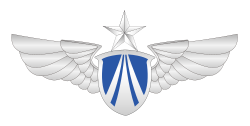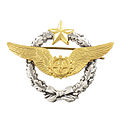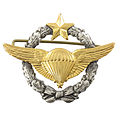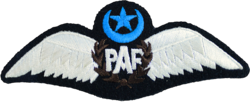1913-1920
Several badges were donated to German aircrew prior, during or after the First World War. The most notable were: [2] [3]
The Military Pilot Badge was donated on January 27, 1913 by Emperor Wilhelm II. It could be awarded to officers, NCOs and crews who, after completing the two required tests for pilots and after completing their training at a military air base, acquired the certificate as a military pilot issued by the military air and land transportation inspection (Inspektion des Militär-Luft- und Kraft-Fahrtwesens). A similar badge for military pilots was donated on 4 February 1913 by Prince Ludwig from Bavaria.
The badge for navy pilots on seaplanes (Abzeichen für Marine Flugzeugführer auf Seeflugzeugen) was donated on 31 May 1913 by King and Emperor Wilhelm II, for all officers and soldiers, who successfully completed the training on a naval aircraft station and thus received a certificate of qualification as a naval pilot.
The badge for navy pilots on land planes (Abzeichen für Marine Flugzeugführer auf Landflugzeugen) was donated on 23 February 1915 by emperor Wilhelm II for pilots of the Navy, who completed their service in the war on land planes.
The badge for observation officers from airplanes (Abzeichen für Beobachtungsoffiziere aus Flugzeugen) was donated on January 27, 1914 by emperor Wilhelm II. Prerequisites for the award were: 1. a distance traveled of at least 1000 km in an aircraft, 2. a successfully completed technical assistance examination on an aircraft, 3. pass of at least one retake, 4. accomplished exploration missions, and 5. a certification as an observation officer. A similar badge was donated by King Ludwig III. on 3 March 1914 for the Bavarian army.
The airgunner badge (Abzeichen Flugzeug-Fliegerschützen) was founded on January 27, 1918 by emperor Wilhelm II. The soldiers had to demonstrate in-depth knowledge in engine construction and operation, in flight training, in map reading, in the tactics of aerial combat, in theory of bombing, and skills in the operation of machine guns on the ground and in aerial combat.
The commemorative badge for airship crews (Erinnerungsabzeichen für Besatzungen der Luftschiffe) was donated in 1920 by Reichswehr Minister Otto Gessler. There were two versions for Army and Navy airships. Upon request, it was awarded to officers, deck officers, NCOs and crews of former airship crews, who during the war had at least one year of activity on front aircraft.



















































